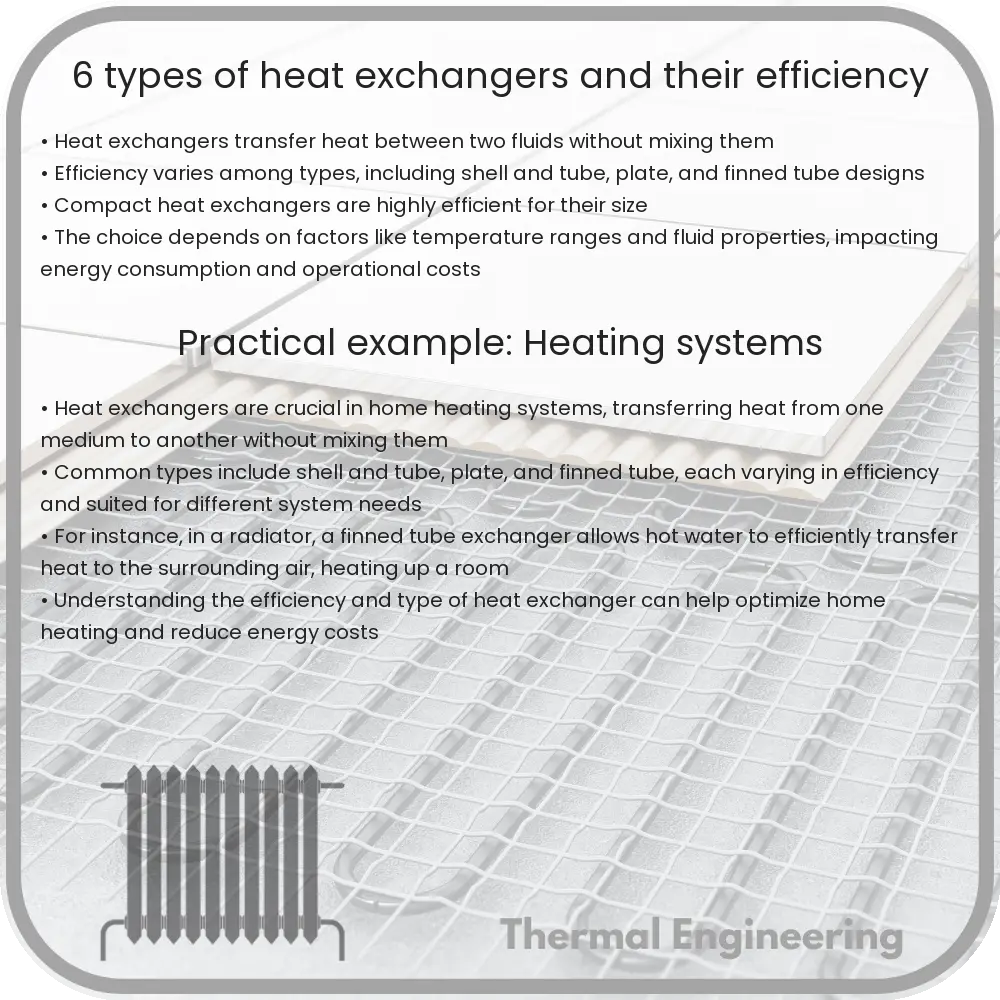Learn about heat exchangers, devices essential for transferring heat between fluids in various industrial applications.

Introduction to Heat Exchangers
Heat exchangers are devices designed to transfer heat between two or more fluids—liquids, vapors, or gases—of different temperatures. Depending on the type of heat exchanger employed, the heat transferring process can be gas-to-gas, liquid-to-gas, or liquid-to-liquid and may occur in a direct or indirect contact manner. The efficiency of heat exchangers is a critical aspect in industrial applications, including power plants, chemical processing, HVAC (Heating, Ventilation, and Air Conditioning), and refrigeration systems. Understanding the different types of heat exchangers and their efficiency helps in selecting the right type for the right application, ensuring optimal performance.
Types of Heat Exchangers
Heat exchangers are classified into several types based on their design and operating principles. Here, we discuss six common types:
- Shell and Tube Heat Exchanger
This is one of the most common types used in various industries. It consists of a series of tubes, one set carrying the hot fluid while the other carries the cold fluid. The tubes are enclosed in a shell, and heat is exchanged as one fluid flows inside the tubes and the other flows outside the tubes but inside the shell. Shell and tube exchangers are popular due to their robust design and ability to withstand high pressures.
- Plate Heat Exchanger
Plate heat exchangers feature thin, corrugated plates stacked together, forming channels through which the fluids flow. The ridges of the plates create turbulent flow, promoting efficient heat transfer. These exchangers are known for their high heat transfer efficiency, compact size, and lower setup costs. They are ideal for applications with smaller volumes and lower temperature variances.
- Fin Tube Heat Exchanger
Also known as finned coil heat exchangers, these devices use tubes with external fins to increase the surface area for heat exchange. Typically used in applications involving the transfer of heat from a liquid to a gas or vice versa, fin tube exchangers are commonly found in automotive radiators, air conditioning systems, and heat recovery units.
- Air Cooled Heat Exchanger
Also known as air coolers, these use fins or fans to cool the fluid by passing ambient air over the heat exchange surface. They are particularly useful in situations where water for cooling is scarce. These heat exchangers are typically employed in process, power plants, and gas compression systems.
- Regenerative Heat Exchanger
This type allows the same fluid to be used both as the heating and cooling medium by storing heat temporarily before transferring it back to the fluid. Common in industrial applications involving gas heating and cooling systems, regenerative heat exchangers are highly efficient in energy recovery processes as they can capture and reuse energy.
- Condensers and Evaporators
Commonly categorized as specialized types of heat exchangers, condensers and evaporators play key roles in HVAC and refrigeration. Condensers release heat from the refrigerant gas to convert it back to a liquid, while evaporators absorb heat from the environment to convert the refrigerant from a liquid to a gas.
Evaluating Efficiency of Heat Exchangers
The efficiency of heat exchangers is often gauged by their ability to transfer heat without significant energy losses. Factors influencing the efficiency include the surface area, flow arrangement, and temperature gradients. Engineers use a dimensionless number, known as the effectiveness (\(\epsilon\)), to describe the performance of a heat exchanger. It is defined as the ratio of the actual heat transfer to the maximum possible heat transfer:
\[ \epsilon = \frac{Q_{actual}}{Q_{max}} \]
where \( Q_{actual} \) is the actual heat transferred and \( Q_{max} \) is the maximum possible heat transfer under ideal conditions. Higher values of \(\epsilon\) indicate more efficient heat exchanger operations.
Choosing the right type of heat exchanger and considering factors like fluid properties, pressure drops, and operational environments is essential for maximizing efficiency and meeting specific application requirements. With advancements in technology, materials, and design, the efficiency of heat exchangers is continually improving, contributing to more sustainable and cost-effective thermal management systems in various industries.